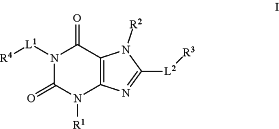| CPC C07D 473/30 (2013.01) [A61K 45/06 (2013.01); A61P 35/00 (2018.01); C07D 473/18 (2013.01); A61P 3/04 (2018.01); A61P 17/06 (2018.01); A61P 19/02 (2018.01)] | 16 Claims |
|
1. A compound of formula I:
 or a pharmaceutically acceptable salt thereof, wherein:
R1 is hydrogen or methyl;
R2 is methyl;
L1 is a covalent bond or a bivalent C1-4 saturated or unsaturated, straight or branched, hydrocarbon chain, wherein one or two methylene units of the chain are optionally and independently replaced by —C(O)NR—, —N(R)C(O)—, —N(R)C(O)NR—, —NR—, —N(R)SO2—, —SO2N(R)—, —C(O)—, —OC(O)—, —C(O)O—, —O—, —S—, —SO—, or —SO2—;
each R is independently hydrogen, or an optionally substituted group selected from C1-6 aliphatic, phenyl, a 4-7 membered saturated or partially unsaturated monocyclic heterocyclic ring having 1-2 heteroatoms independently selected from nitrogen, oxygen, or sulfur, a 5-6 membered monocyclic heteroaryl ring having 1-4 heteroatoms independently selected from nitrogen, oxygen, or sulfur, or an 8-10 membered bicyclic ring having 0-4 heteroatoms independently selected from nitrogen, oxygen, or sulfur; or:
two R groups on the same nitrogen are taken together with their intervening atoms to form a 4-7 membered monocyclic saturated, partially unsaturated, or heteroaryl ring having 0-3 heteroatoms, in addition to the nitrogen, independently selected from nitrogen, oxygen, or sulfur;
L2 is a bivalent C1-4 saturated or unsaturated, straight or branched, hydrocarbon chain, wherein one or two methylene units of the chain are optionally and independently replaced by —C(O)NR—, —N(R)C(O)—, —N(R)C(O)NR—, —NR—, —N(R)SO2—, —SO2N(R)—, —C(O)—, —OC(O)—, —C(O)O—, —O—, —S—, —SO—, or —SO2—, or:
R2 and L2 are taken together with their intervening atoms to form a 5-7 membered partially unsaturated heterocyclic ring having 1-2 nitrogens;
R3 is an optionally substituted C1-6 aliphatic or Ring B optionally substituted with 0-4 independently selected Ry groups;
each Ry is independently halogen, R, —OR, —SR, —N(R)2, —C(O)R, —C(O)OR, —C(O)N(R)2, —N(R)C(O)R, —N(R)C(O)N(R)2, —N(R)C(NR)N(R)2, —NO2, —CN, —SO2N(R)2, —N(R) SO2R, —SO2N(R)C(O)R, —SO2N(R)C(O)N(R)2, —SO2N(R)C(NR)N(R)2, —C(O)N(R)C(O)R or —CR1 (OH) R;
R4 is Ring A optionally substituted with 0-4 independently selected Rx groups;
each Rx is independently halogen, R, —OR, —SR, —N(R)2, —C(O)R, —C(O)OR, —C(O)N(R)2, —N(R)C(O)R, —N(R)C(O)N(R)2, —N(R)C(NR)N(R)2, —NO2, —CN, —SO2N(R)2, —N(R)SO2R, —SO2N(R)C(O)R, —SO2N(R)C(O)N(R)2, —SO2N(R)C(NR)N(R)2, —C(O)N(R)C(O)R or —CR1 (OH) R;
Ring A is a 4-7 membered monocyclic saturated or partially unsaturated carbocyclic ring, a 4-7 membered monocyclic saturated or partially unsaturated heterocyclic ring having 1-2 heteroatoms independently selected from nitrogen, oxygen, or sulfur, phenyl, or a 5-6 membered heteroaryl ring having 1-3 heteroatoms independently selected from nitrogen, oxygen, or sulfur, or an 8-11 membered bicyclic saturated, partially saturated or aromatic ring having 0-3 heteroatoms independently selected from nitrogen, oxygen, or sulfur; and
Ring B is a 4-7 membered monocyclic saturated or partially unsaturated carbocyclic ring, a 4-7 membered monocyclic saturated or partially unsaturated heterocyclic ring having 1-2 heteroatoms independently selected from nitrogen, oxygen, or sulfur, phenyl, or a 5-6 membered heteroaryl ring having 1-3 heteroatoms independently selected from nitrogen, oxygen, or sulfur.
|